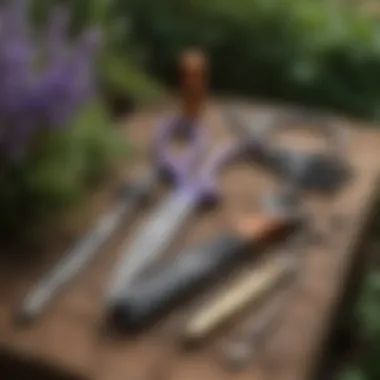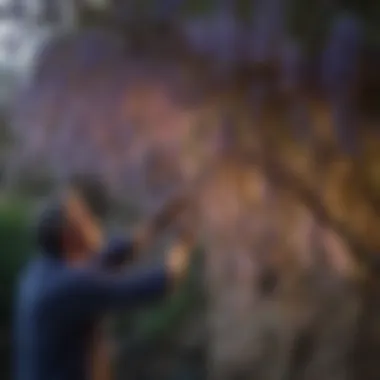Mastering Wisteria Pruning for Stunning Blooms


Intro
Wisteria, with its cascading clusters of fragrant flowers, captivates many homeowners and gardening enthusiasts alike. However, to achieve those stunning blooms, proper pruning techniques and timing are essential. This article delves into the intricacies of wisteria pruning, discussing why it is crucial and how it can influence the vitality of the plant. Fruitful gardening requires knowledge of growth patterns, appropriate tools, and understanding seasonal changes. Here, the aim is to provide valuable insights whether you are just starting your gardening journey or seeking to refine your expertise in caring for these majestic plants.
Why Prune Wisteria?
Pruning wisteria serves multiple purposes:
- It encourages flowering by removing old growth.
- It helps control the size and shape of the plant, preventing it from becoming unruly.
- Pruning promotes healthier growth, reducing the risk of disease and pest infestations.
Understanding these aspects emphasizes the significance of timely and appropriate pruning practices.
Timing Your Pruning
Timing is essential for effective pruning. The best periods for pruning wisteria are in late winter or early spring, just before new growth appears. This allows for the removal of unwanted stems while the plant is still dormant. Often, a second round of light pruning can occur in late summer after flowering has ended. This ensures that energy is redirected towards blooming rather than foliage growth.
"Timing is key in pruning wisteria to maximize blooms while maintaining plant health."
Techniques for Pruning Wisteria
Different techniques apply depending on specific growth habits of wisteria. Here’s a brief overview:
1. Crown Reduction
This method involves shortening long, vigorous stems to encourage bushier growth and promote flowering closer to the main plant structure.
2. Spur Pruning
This technique focuses on cutting back one-year-old shoots to two or three buds. It is designed to enhance the development of flower buds, resulting in prolific blooms in the following growing season.
3. Cleaning Up
Regularly remove dead, damaged, or crossing branches. This ensures sufficient light and airflow within the plant, lowering the chance of disease.
Tools You Will Need
Before you begin, ensure you have the following tools:
- Sharp pruning shears or loppers for clean cuts
- A saw for thicker branches
- Gloves for protection
- Ladder if pruning higher sections
Opting for the right tools makes the process smoother and less stressful for the plant.
Best Practices for Pruning
Following best practices while pruning enhances overall outcomes:
- Always make clean cuts to prevent disease.
- Avoid drastic cuts to maintain plant health.
- Disinfect tools before and after use to reduce transmission of pathogens.
Making these simple yet effective adjustments can lead to a significantly healthier wisteria.
Ending
The practice of pruning wisteria combines art and science, calling for both skill and understanding. Adopting the techniques discussed and ensuring the correct timing can transform your wisteria plant into a visual spectacle. The blend of detail and care reflects a commitment to gardening that can yield beautiful results.
Understanding Wisteria
Wisteria is a fascinating genus of flowering plants known for its stunning blooms and vigorous growth. Understanding the nuances of wisteria is essential for effective pruning, which directly impacts the timing and quality of its blooms. Wisteria plants can be quite robust, and without proper knowledge, gardeners can easily face challenges in managing their growth.
Overview of Wisteria Varieties
Native Species
Native wisteria species, such as Wisteria frutescens, are notable for their adaptability and ease of care. These species are often more resilient to local pests and diseases, making them a favorable choice for gardeners who prefer low-maintenance options. One key characteristic of native species is their ability to thrive in varied soil types, contributing significantly to overall garden biodiversity.
The unique feature of native species is their natural blooming cycle, which may align more closely with local climate conditions. This can lead to spectacular displays in spring with minimal intervention, providing a strong incentive for gardeners to consider.
However, native wisterias may not achieve the same scale and density of flowers as some cultivated varieties. This is a relevant consideration for homeowners aiming for dramatic floral displays.
Cultivated Varieties
Cultivated varieties, like Wisteria sinensis, are prized for their lavish blooms and architectural appeal. These species often produce larger clusters of flowers in various colors, such as purple, white, and pink. The key characteristic of cultivated varieties is their vigorous growth, making them ideal for creating stunning trellises and pergolas.
Cultivated wisteria typically offers longer flowering periods, which can enrich the aesthetic of any outdoor space. However, their aggressive growth may necessitate more frequent pruning and careful management. This makes understanding their growth patterns essential, as it informs the pruning techniques necessary for sustaining healthy plants without overshadowing other garden elements.
Growth Characteristics
Vining Growth Habit


The vining growth habit of wisteria is its most defining characteristic. Wisteria vines can reach considerable lengths and can climb various structures, given the right support. This growth habit allows for creative landscaping possibilities, and it plays a crucial role in how one approaches pruning.
A notable advantage is that wisteria can create a beautiful canopy or a vibrant wall of foliage and flowers. However, this same aggressive growth can lead to untamed behavior if not monitored. It is essential for gardeners to recognize that regular pruning is required to maintain the desired shape and prevent the plant from becoming too invasive.
Root System Examination
Understanding the root system of wisteria is vital for effective planting and pruning. Wisteria generally develops a deep and extensive root system, which enables it to access nutrients and water from the soil effectively. A strong root system is advantageous since it supports the plant’s growth and flowering potential.
However, the depth and spread of the roots can also pose challenges, particularly in confined spaces. Inadequate space can restrict root development, leading to poor plant health. Homeowners need to consider planting wisteria in areas with adequate room for roots to expand. Pruning without recognizing these roots can disrupt the plant's stability and long-term health.
Importance of Pruning
Pruning plays a crucial role in the cultivation of wisteria, affecting both its appearance and health. Proper pruning techniques ensure that plants achieve maximum flowering and maintain a desirable structure. Many homeowners may underestimate the impact of regular maintenance; however, understanding its significance can lead to remarkable transformations in both the plant's growth and aesthetic appeal.
Enhancing Flower Production
One of the primary reasons for pruning wisteria is to enhance flower production. Wisteria blooms on new wood, meaning that the flowers appear on growth that has developed in the current growing season. By pruning early in the year before new growth begins, gardeners can stimulate the plant to produce more vigorous shoots, consequently leading to more blooms. Removing old wood encourages the plant to focus its energy on developing new growth, maximizing the blooming potential.
Additionally, improper pruning may result in reduced flower output. If branches become too dense, they crowd one another, hindering sunlight penetration and air circulation. This situation can lead to fewer flowers and might also invite disease or pests. Regularly thinning the plant reduces competition among branches, leading to a more abundant flowering display.
Promoting Healthy Growth
Pruning is essential for promoting the healthy growth of wisteria. As these plants mature, they can accumulate dead or diseased wood. Removing these sections not only improves the plant’s appearance but also helps prevent the spread of disease. Healthy branches can redirect their resources toward growth instead of attempting to sustain damaged parts.
Moreover, pruning encourages stronger structural development. When weak or poorly positioned branches are removed, the plant can better focus its energy on its main stems. This practice ensures that the remaining branches grow stronger and are less prone to breakage during storms or other environmental stressors. Regular pruning establishes a framework that supports the plant's overall health.
Controlling Size and Shape
Wisteria can rapidly grow into invasive vines if left unchecked. Controlling size and shape through careful pruning is therefore an important consideration. Left to grow wildly, wisteria can overrun an area, smother surrounding plants or structures. This can lead to unsightly tangling and an overwhelming presence that detracts from other garden elements.
Pruning allows for the shaping of the plant, creating a more structured and visually appealing form. Homeowners can choose to shape their wisteria as a beautiful tree, sprawling vine, or guided along trellises. This control over growth not only enhances the plant’s appearance but also allows for the creation of distinct garden features. It is essential to plan the pruning process with the desired shape in mind, ensuring that cuts facilitate the intended development.
"Regular pruning is not just an aesthetic choice; it is a vital practice for ensuring the vitality and longevity of your wisteria."
Pruning Techniques
Pruning techniques are crucial for maintaining the health and beauty of wisteria plants. These methods enhance blooming potential and ensure the plants grow in an aesthetically pleasing manner. Understanding how to properly prune can prevent common issues, such as overcrowded branches and tangles. Additionally, effective pruning can rejuvenate older plants and promote vigorous new growth.
Basic Pruning Methods
Thin Out Old Growth
Thinning out old growth is a fundamental aspect of pruning wisteria. This technique focuses on reducing the density of the plant by selectively removing older branches. By doing so, light and air can penetrate better, benefiting the overall health of the plant. This method is often seen as popular because it encourages the development of new shoots that are vital for flowering. Remove a few of the oldest stems each year to make room for fresh growth.
The key characteristic of thinning is that it aims to improve air circulation within the plant. This helps to prevent pests and diseases that tend to thrive in dense foliage. However, it requires careful selection of which branches to cut. Improper thinning may lead to reduced foliage, which can affect the visual appeal.
Advantages:
- Enhanced Airflow: Better air circulation helps prevent disease.
- Focal Point for Flowers: Directs energy to younger stems that generate blooms.
Disadvantages:
- Potential Over-Pruning: Too many branches removed can reduce plant fullness.
Remove Dead or Damaged Wood
Removing dead or damaged wood is another essential technique in pruning wisteria. This practice helps in improving the overall vigor of the plant. By eliminating unhealthy branches, the plant can allocate its resources more efficiently to healthy parts. This process not only enhances growth but also minimizes potential hazards such as breakage or disease spread.
The critical aspect of this technique is identifying wood that is lifeless or broken. Signs of such wood include discoloration or early leaf drop. Regular inspection for these signs allows gardeners to be proactive. This method tends to add to the longevity of the plant and supports optimal Blooming potential.
Advantages:
- Disease Prevention: Helps mitigate the spread of pathogens.
- Improved Aesthetics: Keeps the plant looking clean and focused on healthy growth.
Disadvantages:
- Neglected Maintenance: Failing to check for dead wood can lead to larger issues.
Advanced Techniques
Structural Pruning
Structural pruning involves shaping the plant for stability and aesthetics. This technique can be essential for training young wisteria or maintaining an established plant. The main goal here is to create a strong framework that can support abundant blooms in future seasons. It requires a keen eye for the overall shape and balance of the plant.
The unique feature of structural pruning is its focus on the arrangement of branches. By removing weak or crossing branches, the structure becomes more robust. This method can be particularly beneficial for trained wisteria on trellises or arbors. Ensuring that branches are spaced well will improve not only the health but also the appearance.
Advantages:


- Balanced Growth: Prevents the plant from becoming lopsided or imbalanced.
- Support for Blooming: Enhances the potential for flowering by prioritizing strong branches.
Disadvantages:
- Injury to the Plant: Improper cuts can lead to stress and reduce blooming ability.
Train Young Vines
Training young vines is a technique focused on directing the growth of young wisteria plants. This can set the stage for how the plant will grow in the future. By guiding the vine along a specific path, gardeners can encourage a beautiful display of blooms later on.
The key characteristic of this method is its emphasis on early intervention. Training should begin in the first few years of growth. This approach allows for the establishment of a strong base that supports future flowering. It can save time and effort later on while establishing an appealing form.
Advantages:
- Early Growth Control: Directs energy into shaping instead of haphazard growth.
- Enhanced Aesthetics: Promotes a visually pleasing structure that supports blooms.
Disadvantages:
- Requires Time and Patience: Initial training can take effort and won't yield immediate results.
Timing Your Pruning
Timing is a critical factor in the pruning of wisteria plants. Choosing the right time to prune can significantly influence the growth and blooming of these beautiful flowering vines. By aligning pruning activities with specific seasonal patterns, you can not only enhance flower production but also promote overall plant health. This section explores when to prune and what signs to look for in determining the best timing.
Seasonal Considerations
Pruning in Late Winter
Pruning wisteria in late winter is often recommended by horticulturists as it offers multiple benefits. This time frame generally occurs just before new growth starts. The primary advantage of late winter pruning is that it allows for a clear view of the plant's structure, making it easier to identify and remove unnecessary or unhealthy growth. By cutting back the tendrils, gardeners can encourage a robust bloom in the coming spring. Another important characteristic is that energy is redirected towards the remaining buds, promoting more vigorous growth.
However, late winter pruning does come with some risks, especially in areas with unpredictable weather. Severe frosts after pruning can damage the exposed plant parts. Therefore, it's essential to evaluate local weather patterns before deciding on this timing.
Summer Pruning Strategies
Summer pruning serves a slightly different purpose. This technique is used to manage the growth and control the shape and size of wisteria. Pruning during the growing season can help keep vines in check, especially if they become too vigorous. A key feature of summer pruning is to remove excess growth that could overshadow potential blooms. This can lead to a more balanced shape overall.
One significant advantage of this approach is that it allows for immediate adjustments and interventions based on observed growth behaviors. However, over-pruning in summer might limit floral development the following season. Therefore, it is crucial to approach this with caution, focusing on maintaining the plant’s aesthetics without overly restricting its potential for blooming.
Signs Indicating Pruning Needs
Monitoring the plant's health and performance is crucial for determining the right time to prune. Observing specific signs will inform you about when the wisteria requires intervention.
Flowering Patterns
Flowering patterns serve as an essential indicator for determining when to prune wisteria. An excessive amount of foliage with little to no blooms may warrant immediate attention. This could suggest that the plant is devoting energy to unproductive growth, which ultimately hinders its ability to flower. Recognizing these patterns early allows for timely corrective actions.
Moreover, understanding the timing of blooms is also beneficial. Pruning right after the flowering period can reset the plant for the next season, encouraging more budding. This knowledge is invaluable; adjusting pruning timing based on observed flowering performance can lead to a cycle of continuous blooming.
Growth Rate Changes
Changes in growth rate can also signal when it is appropriate to prune. If a wisteria appears to be growing too rapidly, stunting its growth might be necessary. Slow growth can indicate stress or health issues, requiring careful assessment. If the growth is slow due to overcrowding or competing plants, thinning out can improve airflow and light penetration.
In summary, monitoring flowering patterns and growth rates offers significant insights into the overall health of the wisteria. Adjustments made based on these observations can ensure the plant develops robustly, guiding it towards optimal blooming in the future.
Tools for Pruning
Understanding the right tools for pruning wisteria is crucial for achieving optimal blooms. The tools you select can impact the effectiveness of your pruning. Quality equipment aids in making clean cuts. This not only promotes healthy growth but also enhances flowering potential. Choosing proper tools can make the process more efficient and enjoyable.
Essential Pruning Tools
Hand Pruners
Hand pruners are one of the most essential tools in any gardener's toolkit. These compact tools allow for precise cuts on smaller branches, effectively removing old growth and dead wood. A key characteristic of hand pruners is their sharp, curved blades, which facilitate smooth cutting. Because they are lightweight and easy to handle, they are a popular choice among both novice and experienced gardeners.
One significant advantage of hand pruners is their ability to make clean and accurate cuts, minimizing the risk of damaging the plant. However, their limitations include a restricted cutting diameter. They may not be suitable for thicker branches, necessitating another tool.
Loppers and Saws
Loppers and saws are important in achieving more extensive pruning tasks. Loppers typically have long handles, allowing for increased leverage and the ability to cut thicker branches. The main feature of loppers is their bypass cutting mechanism, which helps create a clean cut similar to that of hand pruners.
In contrast, saws are used for even thicker limbs that are not manageable with loppers. They often feature sharp blades designed for cutting wood efficiently. Both tools are advantageous for handling tasks that require more strength and reach. Loppers are an excellent choice for reaching higher branches, while saws become necessary for more extensive pruning. The potential drawback is that they may require more effort to use effectively, particularly for denser wood.
Maintenance of Tools
Maintaining your pruning tools is essential to ensure their longevity and performance. Clean and sharp tools help make precise cuts, reducing stress on the plants and boosting growth.
Sharpening Techniques


Sharpening techniques include using a sharpening stone or file to maintain the blade's edge. A key characteristic here is the angle of sharpening. Keeping the correct angle ensures the tool stays effective and cuts cleanly. Regularly sharpening tools is beneficial because dull blades can crush plant tissue instead of making clean cuts, which can compromise plant health. This practice extends the lifespan of your tools, making it a necessary component of tool maintenance.
Cleaning Processes
Cleaning processes are vital after each use. Dirt, sap, and plant material can accumulate on tools, leading to rust and potential disease transfer between plants. One effective method of cleaning includes wiping the blades with a cloth and using rubbing alcohol to disinfect them. This process is a beneficial choice because it helps maintain tool performance and ensures that diseases do not spread to other plants. Consistently cleaning tools after use helps prolong their life and keeps them in optimal working condition.
"The condition of your tools directly impacts the health of your plants."
In summary, understanding the right tools and their care is paramount in the pruning process of wisteria. Proper equipment helps ensure effective techniques are applied, fostering successful blooms.
Aftercare Post-Pruning
After completing the pruning process, the journey does not end. Aftercare for wisteria is crucial to encourage healthy growth and ensure the plant flourishes. Neglecting this step can result in stunted development or decreased flowering. Proper attention during aftercare can maximize the effects of pruning and assist the plant during its crucial growth phases.
Monitoring soil moisture and providing adequate nutrients are two important aspects of post-pruning care. This practice enhances the growth and blooming potential of wisteria, leading to abundant flowers and robust vine health. Focus on watering and feeding, as well as growth monitoring, to achieve these outcomes.
Watering and Feeding
Nutrient Requirements
Wisteria has notable nutrient needs. After pruning, the plant benefits significantly from the right balance of nutrients. Nitrogen is essential for leafy growth, while phosphorus promotes flowering. Potassium plays a role in strengthening the plant's cellular structure.
Choosing a balanced fertilizer is popular among gardeners since it provides comprehensive nutrition. Fertilizers such as 10-10-10 or products specifically formulated for flowering plants can yield significant benefits. They support growth without leading to leggy vines.
One advantage of following structured nutrient requirements is that it sets a foundation for healthy blooms. However, over-fertilization can be a disadvantage, leading to excessive leafy growth and fewer flowers.
Irrigation Techniques
Proper irrigation techniques ensure that wisteria receives adequate moisture, particularly after pruning. Deep watering is a recommended approach. This method encourages deeper root growth by moistening the soil several inches down. Setting an irrigation schedule based on weather patterns can optimize hydration.
Using soaker hoses or drip irrigation systems is beneficial for wisteria because they provide a consistent moisture level without waterlogging the roots. Though a reliable irrigation system can often save time and labor, it requires an upfront investment.
Monitoring Growth
Signs of Successful Pruning
After pruning, observing wisteria's growth can provide clues on whether the actions taken were effective. Healthy, vigorous new growth signifies successful pruning. Strong new shoots and frequent branching are positive indicators.
In addition, blooms appearing during the growing season signal that the plant is thriving post-pruning. This is an advantageous aspect as it assures the gardener of well-executed pruning techniques. However, the absence of new growth or any wilting may highlight potential issues requiring immediate attention.
Identifying Potential Issues
After pruning, it's important to stay vigilant for any signs that indicate problems. Wilting leaves, fungal growth, or pest presence can suggest that wisteria is struggling. Identifying these issues early allows for prompt action, such as adjusting watering habits or treating for pests.
A discernible characteristic of effective monitoring is the ability to respond quickly. This responsiveness can prevent minor problems from evolving into larger concerns, protecting the overall health of the wisteria. Ignoring signs after pruning can have detrimental effects on the plant, underscoring the importance of ongoing observation and care.
Key Takeaway: Aftercare is as vital as pruning itself for ensuring the blooming potential of wisteria. Proper watering, feeding, and growth monitoring are essential steps in this ongoing process.
Common Mistakes in Pruning Wisteria
Pruning wisteria effectively requires a keen understanding of the plant's growth habits and needs. However, many gardeners, whether novice or seasoned, often make common mistakes that can result in reduced blooms or unhealthy plants. Recognizing these errors is crucial for anyone aiming to cultivate vibrant wisteria. Understanding these pitfalls can enhance not only the efficacy of pruning practices but also the overall health and aesthetic appeal of the plants.
Over-Pruning
One prevalent mistake in wisteria care is over-pruning. Gardeners may think they need to cut back heavily to encourage new growth and blooms. However, wisteria has a natural tendency to produce flowers on old wood. Excessive pruning can significantly reduce the number of flowers produced, as it removes the stems that are responsible for blooming.
When pruning, it is vital to focus on thinning rather than cutting back all old growth. Aim to maintain a balance where adequate old wood is left to sustain flowering, while newer growth can be shaped to improve air circulation and light exposure. This approach promotes a healthy environment for your wisteria.
Ignoring Plant Health
Ignoring the overall health of the plant before and after pruning is a mistake that can lead to larger issues. Wisteria might respond negatively if there are underlying health problems, such as pests or diseases, before you prune. If a plant is not thriving, pruning may exacerbate its problems.
Before making any cuts, inspect the wisteria for signs of distress. Look for discolored leaves, stunted growth, or pest infestations. Address these issues first, using suitable treatments or corrective measures. Understand that both the timing and the extent of pruning should align with the plant’s overall health.
Keeping an eye on the holistic condition means ensuring a better outcome post-pruning.
Incorrect Timing
Timing is a critical aspect of pruning wisteria that is often misjudged. Pruning at the wrong time can lead to insufficient blooming. Wisteria should generally be pruned in late winter or early spring before new growth begins. Waiting too long into the growing season can result in the loss of buds that would have produced flowers. Conversely, winter pruning needs to be approached with caution, especially in colder areas.
Being aware of the growth cycle of your specific wisteria variety is essential. Some varieties may have slightly different requirements. It can also be beneficial to observe the pattern of flowering in previous years to inform your pruning schedule. Align your effort with the natural rhythm of the plant for optimal blooming results.
"Pruning at the correct time is just as important as knowing how to prune. This relationship defines the health and bounty of your wisteria."
By avoiding over-pruning, monitoring plant health, and adhering to appropriate timing, gardeners can enhance their wisteria's potential for extraordinary blooms. Taking these common mistakes into account will not only enrich your gardening experience but also the vibrancy of your landscape.
Ending
The conclusion serves as a critical summation of the key elements presented throughout the article regarding pruning wisteria. It highlights the importance of understanding pruning practices not only to achieve lush blooms but also to maintain the overall health and shape of the plant. Pruning is not merely a task; it is an art that cultivates both aesthetic and functional benefits.
Summary of Pruning Practices
In summary, effective pruning practices encompass various techniques that cater to different growth stages and environmental conditions. For instance, thinning out old growth allows light and air to penetrate the plant, which is crucial for new growth development. Likewise, removing dead or damaged wood prevents disease spread and promotes a healthier structure. Implementing advanced techniques, such as structural pruning and training young vines, ensures stability and encourages blossoms. Timing also plays a pivotal role; knowing when to prune strengthens the outcomes. By mastering the techniques outlined in this article, gardeners can enhance the blooming potential of their wisteria.
Encouragement for Continued Learning
Gardening is an ever-evolving discipline, and wisteria care is no exception. As such, homeowners and enthusiasts should not view this guide as the definitive knowledge but rather as a foundation for further exploration. Engaging in forums, like those on Reddit or Facebook, can provide practical insights and experiences from fellow gardeners. Additionally, resources such as Wikipedia or Britannica offer in-depth botanical studies that enrich understanding. Continual learning will deepen insight into the needs of different wisteria varieties and refine pruning techniques over time. This ongoing journey enhances not just the beauty of one's garden but also cultivates a richer experience in gardening overall.



